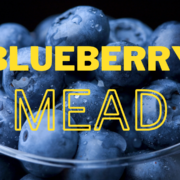Blueberry Mead Recipe – Making A Blueberry Melomel

If you’re a fan of fruit meads and have already tried something like my blackberry melomel, then blueberry mead is worth trying, the recipes are really similar and the flavours are great..
Blueberries, with their rich colour, natural sweetness, and acidity, make for an exceptional blueberry mead that captures the essence of fruit and honey in every sip. Just like its blackberry counterpart, blueberry mead offers complexity by because it is not just the fruit and juice but also the skins which offer complexity and flavour along with the richness of honey.
So, let’s dive into the world of blueberries and mead-making to create a delicious blueberry mead.
Table of Contents
Why Choose Blueberries for Mead?
In the realm of mead-making, fruit-infused meads are known as melomels. As with country wines where pretty much any fruit or even flower or vegetable is ripe for turning into wine there are no end to the various fruits or combinations for mead making.
Blueberries stand out as a perfect candidate for melomel due to their key attributes. The dark skins lend colour and tannins which add depth to the finished mead. The acidity complements the mead’s overall character. Moreover, the fresh flavour of blueberries remains remarkably intact in the finished mead, making it a great choice for preserving a glut and enjoying blueberries in a unique way.
Balancing the Blueberry Melomel
Creating a harmonious blueberry melomel involves some use of wine additives that will ensure a well-rounded and clear final product.
Just like traditional meads, we still employ yeast nutrients, acids, and tannins. Additionally, to extract the maximum juice and flavour from the blueberries, we use pectic enzyme, which breaks down the fruit’s structure and prevents potential issues with haze.
The presence of pectin in fruits like blueberries can cause haziness, but pectic enzymes break down pectins. By breaking down the pectin, we can enjoy a crystal clear mead that compares with any grape wine without any cloudiness.
To achieve a balanced flavour profile, we can incorporate tannin and mixed acid, similar to the approach in fruit wines. Tannins impart a pleasant astringency and bite, while acids add a bright, zesty note, avoiding a flat and lacklustre finished mead. By adding these components at the beginning and, if necessary, at the end of fermentation, we can fine-tune the blueberry mead’s taste and completely tailor it to your own preferences.

The Fermentation Process
When it comes to the fermentation process, mead makers may differ in their approaches to incorporating the fruit. Some prefer to add the blueberries after primary fermentation, as the vigorous fermentation stage can drive off delicate flavours. Others, like myself, opt to include the fruit right from the start alongside the honey. This allows the yeast to efficiently break down the fruit, extracting its juices and flavours from the very beginning.
I would suggest following this recipe and ferment the blueberries from day one until you get a feel for the process. You can always experiment with later additions during fermentation as you progress.
Blueberry Mead Recipe
To make this blueberry mead, follow this simple recipe that yields a gallon or 4.5 litres of blueberry melomel:
What You’ll Need:
- Small Fermenting Bucket
- Demijohn
- Syphon
- Fine Straining Bag
- Potato Masher
- Airlock & Bung
Ingredients
- 1.3 kg Blueberries
- 1.4 kg Honey
- 3 liters of boiled and cooled water
- Zest of 1/2 Lemon
- 1 tsp Acid Blend
- 1/8 tsp Wine Tannin
- 1 tsp Pectic Enzyme
- 1 tsp Yeast Nutrient
- 1 Campden Tablet
- 1 Sachet Wine Yeast
Method:
1. Sanitize the fermenting bucket and secure the straining bag. Add the blueberries to the bag and use a clean masher to gently break them down and extract the juice. Add the lemon zest and secure the bag.
2. Add the honey to the fermenter and pour enough boiled and cooled water to reach a total volume of 4.5 liters. Stir the honey thoroughly with a sanitized spoon before adding the acid, tannin, nutrient, and Campden tablet. Take a hydrometer reading to calculate the potential alcohol content of the mead. Cover the fermenter and let it sit overnight.
3. The next day, add the pectic enzyme, stir, and then sprinkle the yeast onto the surface of the must. Cover the fermenter with an airlock and allow primary fermentation to commence.
4. After 24-72 hours, fermentation will begin. Let it ferment for around 7 days, then remove the straining bag with the remaining fruit and allow it to drain before discarding. Rack the mead to a sanitized demijohn and secure with a bung and airlock.
5. Allow the blueberry melomel to condition in the demijohn for 2-3 months before racking it to another sanitized demijohn and letting it age for approximately 4-6 months. Monitor the progress by taking hydrometer readings during this time to determine the finishing gravity.
6. After conditioning for up to 9 months, sample the mead and adjust with acid and tannin if necessary before bottling. This blueberry mead is delightful as it is, but if you prefer a sweeter mead, consider back-sweetening it using a suitable guide.
7. Bottle the mead and practice patience as you let it mature over time. The blueberry melomel will gracefully age in bottles for a couple of years, enhancing its flavours and delivering an exquisite experience with every sip.
In Conclusion
Blueberry mead, or blueberry melomel, offers a simple journey into the world of fruit-infused meads. Embrace the versatility of mead-making and explore the numerous possibilities of different fruits and flavours that are possible.




Leave a Reply
Want to join the discussion?Feel free to contribute!